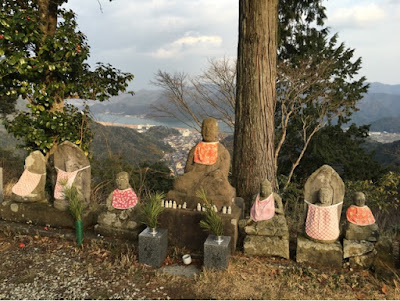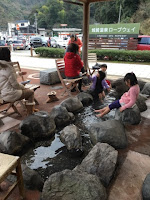Kinosaki Onsen is a lovely town on the west coast of Japan that is known for its hot springs. I stayed at a "ryokan" (Japanese guesthouse) and spent two blissful days eating amazing food, drinking sake, and steeping in natural hot springs.
Kinosaki Onsen is approximately five hours by train from Tokyo. Take the Shinkansen (bullet train) three hours to Kyoto, then another express train for two hours through beautiful countryside to Kinosaki Onsen.
Note: I highly recommend getting the
JR Pass before arriving in Japan - it's a brilliant rail pass only available to foreigners that is all-you-can-ride Japan Railways, including the Shinkansen. You can get reserve seats for no cost as well. You'll usually make up the cost of the pass with one Shinkansen trip.

Shinkansen Pro-tip: Try to get seat E if you reserve seats - the north side window of the train (right side on way south, left north) generally has better views, including Mount Fuji about an hour out from Tokyo. Also fun to track your blue dot on Google Maps, you'll never see the dot move so fast!!
Stay at a Ryokan!
I stayed at Ryokufukaku (beautiful
Japanese website /
English tourist site). 25,000 yen per night for a tatami room, breakfast and dinner, ryokan's baths, and access to the seven "soto-yu" hot springs in town. Pretty incredible deal, as the dinner could easily cost
well over 10,000 yen.
What to do in Kinosaki:
- Onsen ("hot springs") that have been here for 1400 years of geothermal activity is the main attraction and a must do. The ryokan's rent yukata (and hakama overcoats in winter) for guests to wear out to baths. I literally wore that all day. See below for the seven "soto-yu"
- Ropeway at the west end of town will give you a beautiful view of the village and surrounding mountains, all the way to the Sea of Japan.

- Drink local sake - this is a must. Sakamoto-ya Sakaya 坂本屋酒屋 is a liquor shop that offers shots of sake for 300 yen. Two tables outside and four stools at a little window bar to snack and drink your sake or beer or liquor. They have local brews of sake, beer and liqueurs that you can try before you buy. Highly recommend the "ji-zake" 地酒, local fresh brewed sake out of a keg, super rich and potent.
- Eat seafood, Tajima beef and Izushi soba. The ryokan and restaurants alike get fresh seafood daily from the Sea of Japan, and the area is known for crab in winter months.
Izushi is a nearby town, known for its soba plates, eaten five different ways for each serving of five plates (soba sauce, plus grated daikon and negi, plus wasabi, plus grated mountain yam, plus a raw egg).

- Pottery making at Rakugaki is fun and you get something to keep from it. You can make designs, actually shape the clay, or decorate small jewelry. If you paint or sculpt, they'll fire the clay and ship you the final pottery (even overseas, was 1,200 yen to the US). Roughly 2,400 yen to make a cup and chopstick holder.
Onsen
There are seven "soto-yu" 外湯, or "outside springs" that most ryokan's will provide you a pass to enter for free. Each spring also has an a la carte price for day trippers.
So the seven hot springs. Each is named "xx no Yu", which means "Hot Spring of xx". I'm partial to the ones with "roten-buro" or outdoor baths. In order of my favorite:
Gosha no Yu 御所の湯 is styled after a Kyoto palace, the largest and most elegant of the seven, with indoor, steam room and outdoor baths besides several waterfalls. They rotate the men's and women's bath daily so try to hit Gosha no Yu two days in a row to see both sides.
Ichi no Yu 一の湯 is the landmark Kinosaki Onsen and has an outdoor bath carved into a cave.
Kou no Yu 鴻の湯 is the farthest onsen by the ropeway and has an outdoor bath covered by a pagoda.
Mandara no Yu まんだらの湯 had a small wooden bath that seats two by the forest
Sato no Yu さとの湯 is the newest and most modern bath, with multiple floors, baths and saunas. The rooftop outdoor bath feels a bit kitschy but is nice, and I enjoyed the dry heat, steam and penguin (0-5 degree C!) saunas
Yanagi no Yu 柳の湯 is one of the smallest but with beautiful wood in the high beams that make up the indoor bath
Jizo no Yu 地蔵の湯 has an indoor bath inside a nice multistory inn.
Ashi no Yu 足の湯 are foot baths along the main roads and free for anyone to stop and dip their feet. Sato no Yu and Yanagi no Yu have them, and there is one near the corner by Ichi no Yu with a beautiful view of the street (also conveniently close to Sakamotoya liquor shop if you get a sake to go) and also by the ropeway. Good stop while you wait 11 min for your onsen eggs.
By the way, your ryokan is likely to have its own hot spring, and perhaps even some private Onsen that you can reserve!
Last note: Kinosaki Onsen is a pretty local tourist spot. Even the Japanese tourists are primarily from the Kansai region, and while they're starting to see more Chinese tourists, non-Asian foreigners are less common. So just note, it's a tourist spot with very little English speakers, though Kansai folks are super friendly as a whole and I'm sure they will do everything in their power to be hospitable!




















